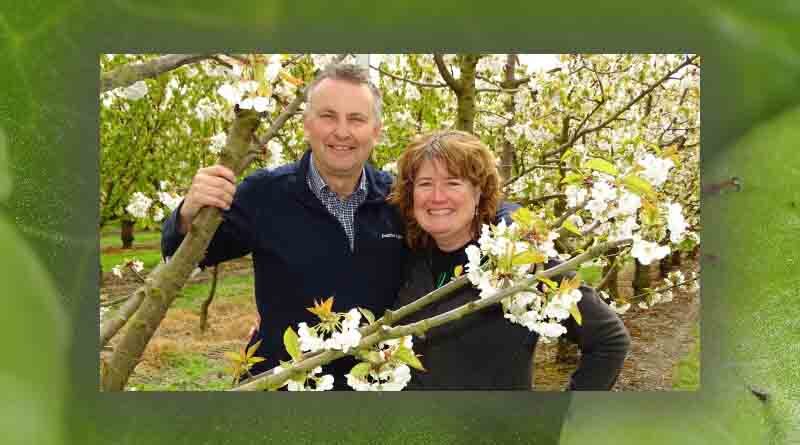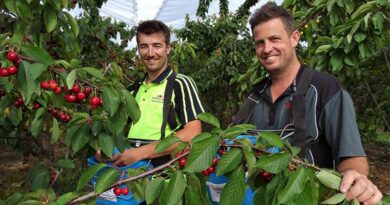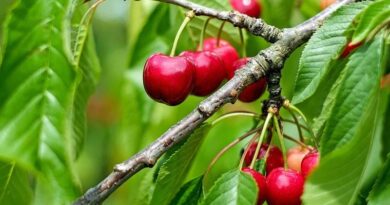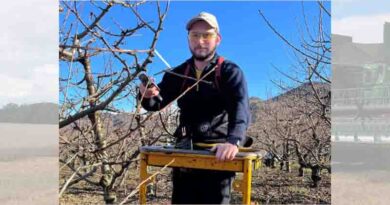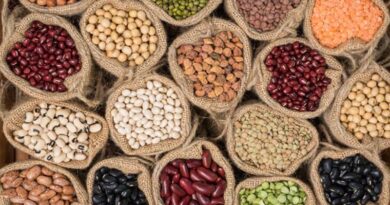Innovating for the perfect cherry, every time
16 November 2022, NZ: Marlborough’s cherry tree of the future grows on a fully trellised system, under narrow sheets of rain cover to protect its fruit from the “dreaded split”. It’s one of many examples across the country where orchards are using innovative growing techniques to achieve the perfect cherry every season. ANNE HARDIE reports.
Caythorpe Family Estate near Blenheim are using the new system, where owner, Simon Bishell, has begun converting the four-hectare cherry orchard to the upright shooting offshoot (UFO) growing system, installing 1.5-metre-wide rain covers for each row as extra insurance.
It took a couple of years of research with Motueka-based sustainable growing structure company, Hortivate, to come up with a retractable rain cover system that fits with the bird cloth. They settled on Italian Valente and Chilean Wayki technology as the system also needed to be able to cope with the nor’westers that blow across the region – which Simon says are Marlborough’s “best kept secret”.
The nor’westers are great for keeping fungus at bay, he says, but prove challenging for erecting rain cover. Hence, Simon chose to erect 1.5m widths of the PVC-polymer cloth with 1.5m between rows to allow the wind to escape, rather than erecting a large area of rain cover that could potentially turn into a kite.
Hail cover is used by apple growers in Nelson over similar trellis systems, but Simon says it gets quite technical to integrate narrow widths of rain cover that needs to be retractable, let alone work with the bird netting above. Simon has erected one set of concrete poles over the UFO plantings that will be multi-purpose for the fully automated retractable rain cover, bird netting and tree support wires. That makes it more efficient as well as cheaper. To cover the trellis system with rain cover and bird netting will cost about $200,000 per hectare, excluding installation.
The rain cover will be placed over a few rows of Caythorpe Family Estate’s UFO plantings next year and all going well, will be rolled out over more of the orchard the following year.
Simon says more significant rain events prompted the move to rain cover in a bid to mitigate the risk of losing significant quantities of the valuable fruit when rain coincides with harvest. By mid-August this year, the orchard had already had its usual annual rainfall, and the past couple of harvests have been affected by rain.
The older central leader plantings of cherry trees will be replaced with the UFO system too – the goal being to produce more cherries per hectare while decreasing the reliance on labour. Replacing the central leader plantings will enable a “pedestrian picking system” that requires fewer people because they can pick fruit faster.
“Picking [UFO trees] is almost 50 percent faster than central leader trees, and the same again at pruning,” Simon says. “That’s a significant saving in labour once trees are fully established.
“I do believe some time in the future there will be a robotic harvester for cherries. When that does arrive, if you have 2D canopies it will be much easier to adapt for automation and robotics.”
About half the cherry orchard is now planted in the UFO growing system. The trees are still young but will reach full production at four years’ old. Simon admits that when he first saw UFO plantings about ten years ago, he was not convinced. It looked like a lot of work installing the system and establishing the crop. But after seeing an established UFO orchard at Lake Terrace Cherries in Central Otago, he had a “lightbulb moment” that resulted in an overhaul of the home crop.
When the initial tree is laid horizontally, it naturally wants to send shoots upward at the trunk. Simon says the first year is spent controlling that upright growth to promote horizontal growth at the terminal end of the tree. Once the horizontal growth is established, management of the system switches to generating good upright branches 200mm apart. Those uprights will then grow to three metres, creating a wall of cherries to harvest.
Conservative estimates put full production at 20 tonnes of fruit per hectare, depending on factors such as pollination which can be fickle in Marlborough if there is not enough winter chilling for fruit buds to become viable.
Average returns for the cherries are approximately $10 to $15 per kilogram, with the bulk of the Caythorpe crop sold through wholesale markets in the North Island, and a small amount sold direct to consumers through its website.
Marlborough cherries ripen before those in Central Otago, hitting that sweet spot in the lead-up to Christmas. At Caythorpe Estate, Rosann is followed by Santina and then Lapins and Stella, with a few of the white Rainier cherries added into the mix.
At just four hectares, the cherry orchard is a small fraction of the business which encompasses 140 hectares of vineyard and 45 hectares for stock and hay. But Simon says that in a good year, the cherry crop can return five times the value of grapes on a per hectare basis.
Rain cover is aimed at achieving those results more often – a factor of the business that Caythorpe Estate has invested heavily in.
On the other side of Blenheim, Cherrybank Orchard is gearing up to sell cherries from its prime position on State Highway 1. Blair and Mel McLean are heading into their eighth season growing cherries and third as owners after working alongside in a partnership and then buying the ten-hectare orchard from Bernie and Trish Rowe.
Blair and Mel experienced four wet seasons in a row during a short and intense three-week harvest before Christmas. So, like Simon at Caythorpe Estate, they are taking measures to mitigate fruit losses in a changing climate, including rain cover and replacing softer varieties.
“Rain is our nemesis,” says Brian. “You can lose 50 percent of your crop in one event. You can handle frosts at fruit set, but not rain in December.”
Rain leaves water sitting around the stem of the cherries which leads to split fruit with a limited shelf life. Rain is also taken up through the trees’ roots which makes the cherries softer and prone to splitting too. Flying a helicopter over the orchard and driving sprayers between the trees to blow air at the fruit helps to dispel water, but it is an expensive exercise.
They have replaced a large chunk of varieties such as Stella which splits “when a cloud passes over” with 600 Lapins trees which is a large, hardy cherry variety that handles the rain better. About 50 percent of their orchard is now planted in Lapins, with some varieties such as Rosann and Samba still planted too.
The remaining Stella trees will be placed under rain cover soon. The older, established trees have been grown in the central leader style, meaning the McLeans will need to have a rain cover method that is four metres wide in order to cover the trees. It will be erected beneath the existing bird netting structure.
“We had to find something to put on conventional trees with an existing structure and to our budget,” says Mel. “It’s pretty much the number eight wire system.”
It had to be versatile and easy to retract manually once the rain is over. The end result – yet to be installed – is a Central Otago produced method to fit their system.
Newer plantings of Lapins have been grown in the UFO growing system and should not need the protection of rain cover, partly because the cherries are hardier but also because the growing system enables the fruit to dry better after rain.
“We’ve decided UFO is the way to go,” says Mel. “That’s our motto.”
Two hectares of the orchard are now planted in the UFO trellis system and Brian says pickers love it because it is easier and quicker. They will continue to replace central leader trees with UFO plantings, which will set the orchard up for mechanisation down the track.
Cherrybank Orchard sell their fruit at the gate and through MG Marketing to the domestic market. Every year the couple have been growing cherries they had set up to export some of the crop but have only managed to do so for a couple of years due to weather related quality issues.
“You have to make sure you sell quality fruit to export markets,” says Blair.
He says the quality of exported cherries has been dropping as growers push the limits to achieve higher prices, and it risks New Zealand’s reputation for premium fruit. New Zealand exports just 3000 tonnes of cherries compared to Chile’s 300,000 tonnes. Blair says the industry needs to work together to ensure New Zealand cherries continue to be regarded as a premium fruit.
Less than five percent of their crop is sold via the shop or pick-your-own, but it provides a vital link with customers including locals, who have three generations making the annual trip to the orchard to pick cherries.
“It’s almost an old-fashioned thing to do, to walk out into an orchard and pick your own fruit,” says Mel. “There’s health and safety issues with pick-your-own and you can have people breaking branches, but I love the fact you have people walking through the orchard picking their own fruit.”
Through the three-week harvesting frenzy, the orchard employs between 70 and 80 staff, with about 30 of those picking cherries and the remainder in the packhouse. The total number cater for different rosters during the seven-day-a-week harvest. Finding staff has not been an issue, partly due to the timing of the harvest pre-Christmas which works well for school leavers and university students. Mel says they welcome 15-year-olds too, who make boxes and wash buckets in their first year and then return for several years with increasing experience.
“They’ll come back through their university holidays and it’s lovely watching the kids grow.”
About half their seasonal staff are locals and the remainder are backpackers on working holiday visas who view cherries as an opportunity to make good money, with some earning up to $400 a day. The harvest finishes just in time for them to head south for the start of the cherry harvest in Central Otago.
Also Read: CropLife India appoints Durgesh C Sharma as the new Secretary General
(For Latest Agriculture News & Updates, follow Krishak Jagat on Google News)

